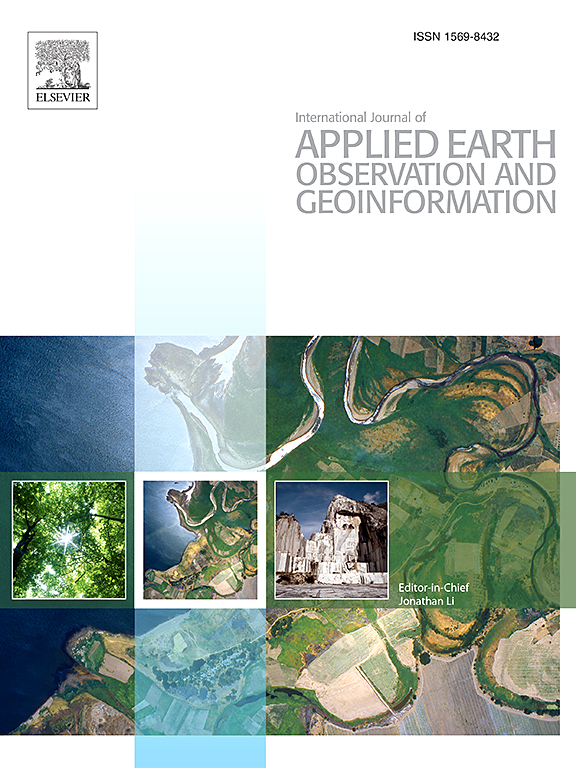Exploring UAV narrow-band hyperspectral indices and crop functional traits derived from radiative transfer models to detect wheat powdery mildew
IF 8.6
Q1 REMOTE SENSING
International journal of applied earth observation and geoinformation : ITC journal
Pub Date : 2025-05-28
DOI:10.1016/j.jag.2025.104627
引用次数: 0
Abstract
The wheat powdery mildew (WPM) is one of the most severe crop diseases worldwide, affecting wheat growth and causing yield losses. The WPM was a bottom-up disease that caused the loss of cell integrity, leaf wilting, and canopy structure damage with these symptoms altering the crop’s functional traits (CFT) and canopy spectra. The unmanned aerial vehicle (UAV)-based hyperspectral analysis became a mainstream method for WPM detection. However, the CFT changes experienced by infected wheats, the relationship between CFT and canopy spectra, and their role in WPM detection remained unclear, which might blur the understanding for the WPM infection. Therefore, this study aimed to propose a new method that considered the role of CFT for detecting WPM and estimating disease severity. The UAV hyperspectral data used in this study were collected from the Plant Protection Institute’s research demonstration base, Xinxiang city, China, covering a broad range of WPM severity (0–85 %) from 2022 to 2024. The potential of eight CFT [leaf structure parameter (N), leaf area index (LAI), chlorophyll a + b content (Cab), carotenoids (Car), Car/Cab, anthocyanins (Ant), canopy chlorophyll content (CCC) and average leaf angle (Deg)] obtained from a hybrid method combining a radiative transfer model and random forest (RF) and fifty-five narrow-band hyperspectral indices (NHI) was explored in WPM detection. Results indicated that N, Cab, Ant, Car, LAI, and CCC showed a decreasing trend with increasing disease severity, while Deg and Car/Cab exhibited the opposite pattern. There were marked differences between healthy samples and the two higher infection levels (moderate and severe infection) for Cab, Car, LAI, Deg, CCC, and Car/Cab. N and Ant only showed significant differences between the healthy samples and the highest infection level (severe infection). As Cab, Car, and Ant decreased, the spectral reflectance in the visible light region increased. The decrease in N and LAI was accompanied by a reduction in reflectance across the entire spectral range and the near-infrared area, which was exactly the opposite of Deg. The introduction of CFT greatly improved the accuracy of the WPM severity estimation model with R2 of 0.92. Features related to photosynthesis, pigment content, and canopy structure played a decisive role in estimating WPM severity. Also, results found that the feature importance showed a remarkable interchange as increasing disease levels. Using features that described canopy structure changes, such as optimized soil adjusted vegetation index, LAI, visible atmospherically resistant indices, and CCC, the mild infection stage of this disease was most easily distinguished from healthy samples. In contrast, most severe impacts of WPM were best characterized by features related to photosynthesis (e.g., photochemical reflectance index 515) and pigment content (e.g., normalized phaeophytinization index). This study help deepen the understanding of symptoms and spectral responses caused by WPM infection.
基于辐射转移模型的无人机窄带高光谱指数和作物功能性状检测小麦白粉病研究
小麦白粉病是世界范围内最严重的作物病害之一,严重影响小麦生长,造成产量损失。WPM是一种自下而上的病害,导致细胞完整性丧失、叶片萎蔫和冠层结构破坏,这些症状改变了作物的功能性状(CFT)和冠层光谱。基于无人机的高光谱分析成为WPM检测的主流方法。然而,小麦侵染后的CFT变化、CFT与冠层光谱的关系及其在WPM检测中的作用尚不清楚,这可能会模糊对WPM侵染的认识。因此,本研究旨在提出一种考虑CFT在WPM检测和疾病严重程度评估中的作用的新方法。本研究使用的无人机高光谱数据来自中国新乡市植保所研究示范基地,涵盖2022 - 2024年WPM严重程度(0 - 85%)的广泛范围。利用辐射转移模型与随机森林(RF)和55种窄波段高光谱指数(NHI)相结合的杂交方法,探讨了8种CFT[叶片结构参数(N)、叶面积指数(LAI)、叶绿素a + b含量(Cab)、类胡萝卜素(Car)、Car/Cab、花青素(Ant)、冠层叶绿素含量(CCC)和平均叶角(Deg)]在WPM检测中的潜力。结果表明,N、Cab、Ant、Car、LAI和CCC随疾病严重程度的增加呈下降趋势,而Deg和Car/Cab呈相反趋势。健康样本与Cab、Car、LAI、Deg、CCC和Car/Cab两种较高感染水平(中度和重度感染)之间存在显著差异。N和Ant仅在健康样本和最高感染水平(严重感染)之间存在显著差异。随着Cab、Car和Ant的减小,可见光区的光谱反射率增大。N和LAI的降低伴随着整个光谱范围和近红外区域反射率的降低,这与Deg正好相反。CFT的引入大大提高了WPM严重程度估计模型的精度,R2为0.92。与光合作用、色素含量和冠层结构相关的特征对WPM的严重程度起决定性作用。此外,结果发现,随着疾病水平的增加,特征重要性表现出显著的交换。利用优化土壤调整植被指数、LAI、大气可见抗性指数、CCC等描述冠层结构变化的特征,最容易将本病的轻度侵染期与健康样品区分。相比之下,WPM最严重的影响可以通过与光合作用相关的特征(如光化学反射指数515)和色素含量(如归一化褐化指数)来最好地表征。本研究有助于加深对WPM感染引起的症状和谱反应的理解。
本文章由计算机程序翻译,如有差异,请以英文原文为准。
求助全文
约1分钟内获得全文
求助全文
来源期刊

International journal of applied earth observation and geoinformation : ITC journal
Global and Planetary Change, Management, Monitoring, Policy and Law, Earth-Surface Processes, Computers in Earth Sciences
CiteScore
12.00
自引率
0.00%
发文量
0
审稿时长
77 days
期刊介绍:
The International Journal of Applied Earth Observation and Geoinformation publishes original papers that utilize earth observation data for natural resource and environmental inventory and management. These data primarily originate from remote sensing platforms, including satellites and aircraft, supplemented by surface and subsurface measurements. Addressing natural resources such as forests, agricultural land, soils, and water, as well as environmental concerns like biodiversity, land degradation, and hazards, the journal explores conceptual and data-driven approaches. It covers geoinformation themes like capturing, databasing, visualization, interpretation, data quality, and spatial uncertainty.
 求助内容:
求助内容: 应助结果提醒方式:
应助结果提醒方式:


